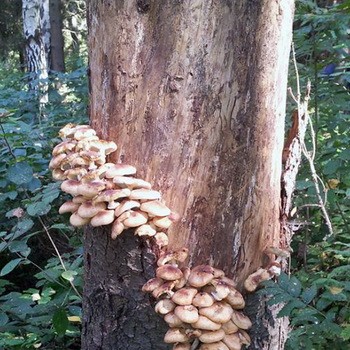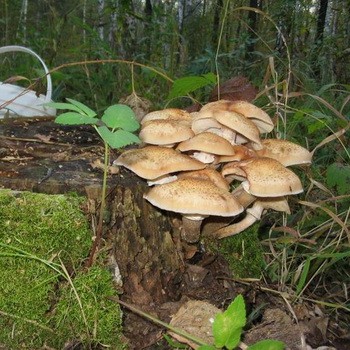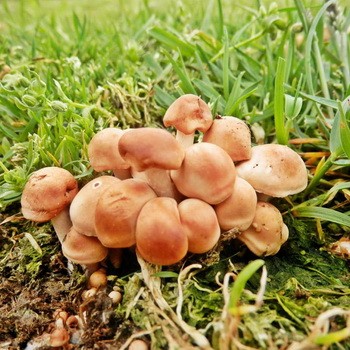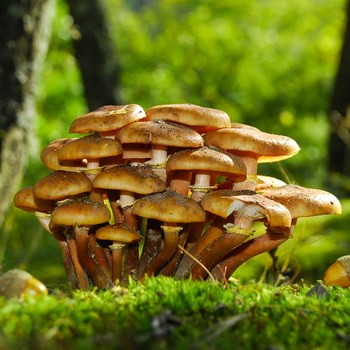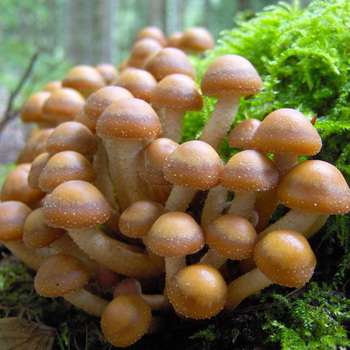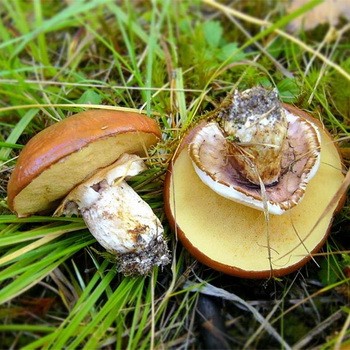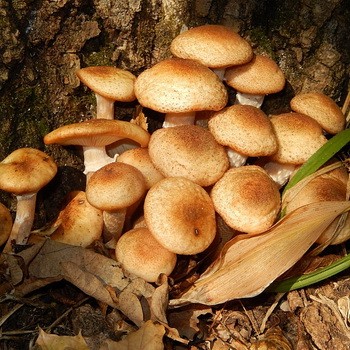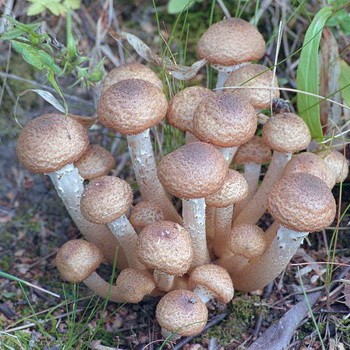Honey mushrooms growing on birches: edible and false mushrooms
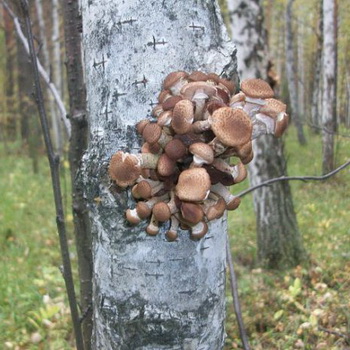
Usually honey mushrooms grow on birches, choosing sick trees for themselves. However, these mushrooms can be found on other trees, including fruit species. Autumn mushrooms are especially popular with mushroom pickers. They grow in large quantities and, having found only one family of this species, “silent hunting” turns into a monotonous process of cutting mushrooms and putting them in baskets. Processing these mushrooms requires a minimum of time, as honey mushrooms growing on a birch or other tree are always clean, without forest debris and sand.
We offer you to see a photo of honey mushrooms on a birch, showing visually how these fruiting bodies grow. Almost all of them are saprophytes in nature, that is, parasites that destroy the remains of living representatives of the plant world.
Content
Do honey mushrooms grow on birches?
Some of the honey mushrooms quite often settle on healthy plants and very quickly destroy them. According to experts, in the middle zone of Russia it is these fruiting bodies that have recently become the cause of death of birch groves.
Edible mushrooms growing on birch trees belong to categories III and IV by nutritional value. However, many mushroom lovers consider them one of the best for picklingfrosts drying and salting. Therefore, starting in May, as soon as the spring hunting season opens, mushroom pickers begin picking honey mushrooms. It is worth noting that for all types of mushrooms there are no common external signs that help determine their edibility. So, any particular type of given fruiting bodies is able to partially “change the appearance”. It all depends on the weather or the type of wood on which honey mushrooms grow.
Some novice mushroom pickers wonder: Do all mushrooms grow on a birch? Note that the habitat of many honey agarics is damaged and weakened trees, rotten and dead wood, mainly birch. The next species of honey select such tree species as oak, alder, willow, elm, beech, poplar, acacia and ash. Honey mushrooms grow much less often in coniferous forests: on pine, fir or spruce. Check out the photo showing how honey mushrooms grow on birches:
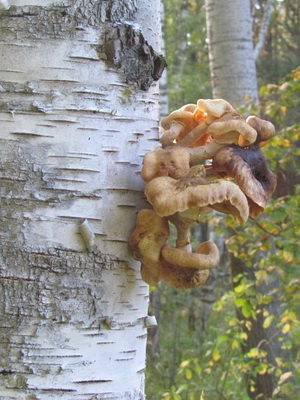
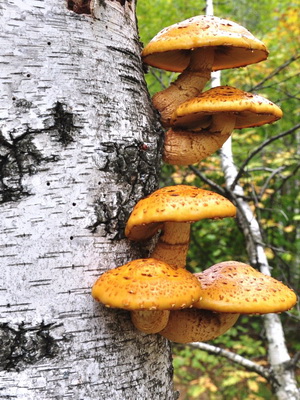
It is worth saying that meadow honey agaric does not grow on trees at all. This species prefers to grow on open grassy spaces: roadsides, forest glades, ravines, fields and garden plots.
Summer, autumn and winter mushrooms growing on birches
Winter mushrooms
However, winter mushrooms are the most recognizable for mushroom pickers. Its fruiting begins in late autumn and can last all winter, until the month of March. It grows not only on deciduous trees, including birch, but also on stumps and deadwood. We offer you to familiarize yourself with the photo and description of honey mushrooms growing on a birch in winter:
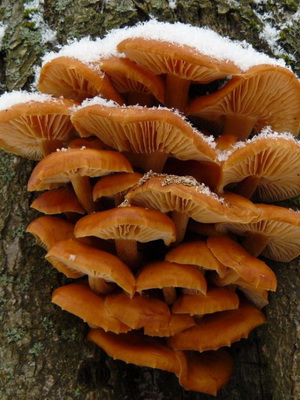
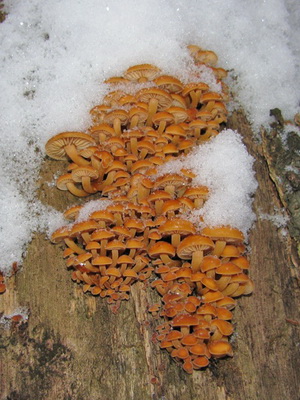
These fruit bodies have a honey-brownish tint on the hat, which is completely smooth. In young specimens, the cap is hemispherical; in adults, it is open.With thaws, it becomes mucous, and the color of the plates acquires a cream color. In addition, there are no scales on the hats, and there is no “skirt” on the leg. But this is absolutely not important, since the winter honey agaric can not be confused with a false appearance, because the latter does not grow in such a cold period. You can safely go to the winter forest in search of these fruiting bodies, which can be found even under the snow.
Mushrooms summer
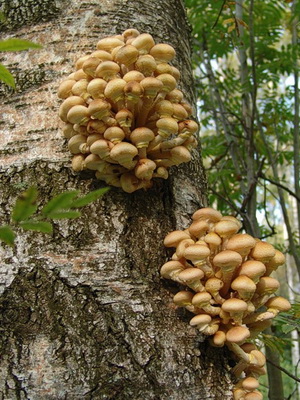
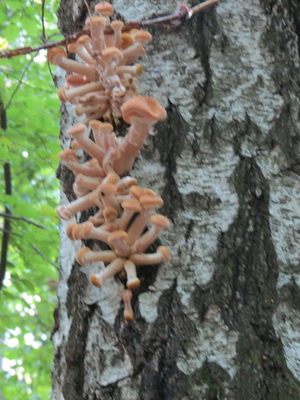
A photo of edible mushrooms on a birch will help you visualize how summer species grow. These fruiting bodies begin to bear fruit abundantly from April and continue until mid or late October, depending on weather conditions. In addition to growing on birch trees, summer mushrooms grow on almost all deciduous trees. Often this species is found on birch stumps and rotten wood. In mountainous areas, summer mushrooms grow in coniferous forests. Young mushrooms have a small, convex and covered with a film at the bottom of the hat. With age, the hat becomes flat-convex, the coverlet forms a "skirt" on the leg. The plates are creamy brown, and the legs also have small scales.
Autumn mushrooms
Autumn mushrooms grow on birch, oak, alder, poplar, acacia and other deciduous trees. For a better review, we present to you a photo and a description of the mushrooms mushrooms, "settling" on a birch:
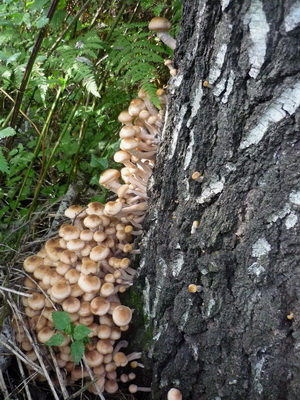
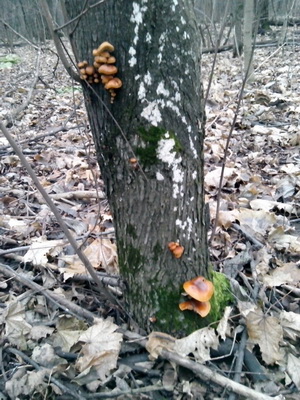
This species is characterized by noticeable signs of difference from other mushrooms. His hat in adulthood can reach up to 15 cm in diameter, has small scales. The color of the hat ranges from gray-yellow to yellow-brown. The leg of honey mushrooms is framed by a clear "skirt" and covered with the same small scales as the hat. Since the spores of autumn honey mushrooms are white, sometimes old individuals seem moldy. The pulp always has a pleasant smell, even when the mushroom is overripe. Autumn honey mushrooms have one natural uniqueness - at night these fruit bodies glow and highlight the place on which they grow. Mushroom pickers collect them in moist forests, planted forests or in clearings around birch and oak stumps. Sometimes autumn mushrooms do not hesitate to grow on shrubs or even herbaceous plants such as potatoes. Although these mushrooms prefer birch more, they can settle on 200 species of trees. The season of collecting autumn mushrooms begins in mid-August and lasts until November, if the temperature is not
drops below 12 ° C heat. Photos of mushrooms growing on birch mushrooms will help you better know and determine this species:
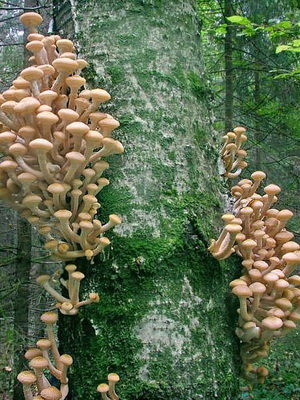
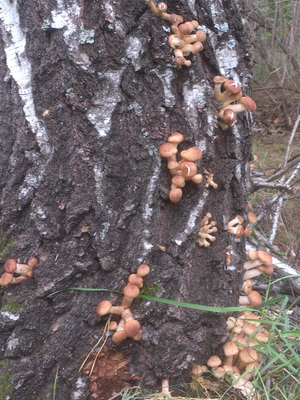
Do false mushrooms grow on birches?
For many beginner mushroom pickers, the question of whether false mushrooms grow on a birch is interesting. First, let’s tell you how to distinguish false mushrooms from their edible counterparts. The main difference between all false counterparts is the absence of a film - skirts on the legs. The flesh of false honey agarics has a pale yellow color, with an unpleasant decaying smell. The hats have no scales at all, and the legs are hollow. In addition, all false honey mushrooms never grow on trees. They are located at the foot of trees, on rotten stumps or rotting wood. However, they grow as large colonies as edible mushrooms. Often found in mixed forests or deciduous. False mushrooms are characterized by the harvest season from July to October, sometimes this species can be found even in November when the weather is warm. The color scheme of all false honey mushrooms has bright shades, in real species the colors are calmer and more matte.
I would like to caution novice fans of the "mushroom hunt": if you are not sure about the shape of honey, it is better not to risk it and not take it to the basket. In addition, never collect honey mushrooms in industrial areas, as they have the ability to accumulate poisonous substances and salts of heavy metals. Also go around places near highways and railways, it is better to go deep into the woods or forest plantations.
